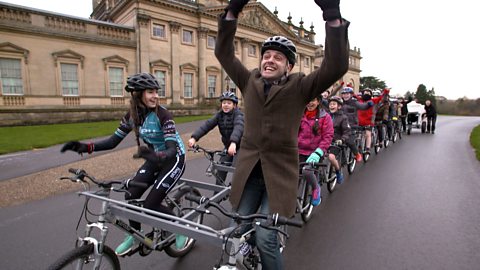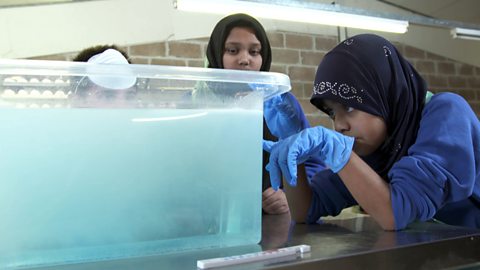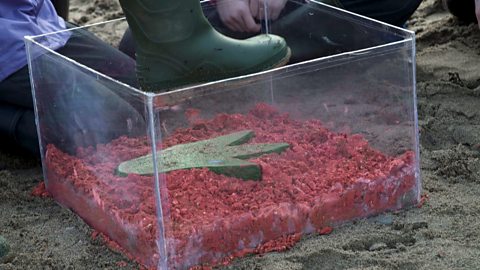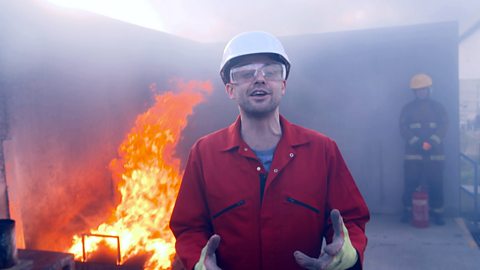STEVE:This amazing pool is where oil rig workers come when they want to learn how to be safe working in the middle of the ocean, but I've brought a team of students here to look at the science of floating.
STEVE:'First the helicopter drop. How would you survive if your helicopter was forced to land in the sea? We're about to find out.
STEVE:'It's hard to keep calm, but one at a time, we release our belts get to the door and out into the pool.'
STEVE:'We've got safety divers to help us to the life raft. If it was real, we'd be on our own.'
STEVE:'Though it looks like we've left something at the bottom of the pool.'
STEVE:Alright is everyone safe?
ALL: Yes.
STEVE:Great well done. Now I've got some bad news, which is, that I had a box of treasure in the helicopter and unfortunately it fell out when we we're going into the water and it's now at the bottom of the pool.
STEVE:And I've spoken to the divers and they say it's too heavy for them to lift out.
STEVE:So, your challenge is to rescue my treasure And you've got to use science to do it so we're gonna try and figure out how to raise this treasure from the bottom of the pool.
STEVE:Any ideas, how we could do it? Yes.
CHILD #1:Buy a crane.
STEVE:Buy crane I love that idea. There is no crane shops nearby, what can we do?
CHILD #2:We could use air.
STEVE:Yeah air, why would we use air?
CHILD #3:Because it floats like this. Air.
STEVE:Because it floats, yeah. Like this yeah 'cause this is all air round here that's making us float. Should we work it out?
STEVE:Should we try and work out how much air we need to lift the thing?
STEVE:'I'm depending on these guys to get my treasure back.'
STEVE:My treasure, I know, is 25kg, that's how much it weighs. So we're gonna send the divers down there, they're going to fill some balloons full of air and the air that they use to fill those balloons is going to be the same air that they use to breathe.
STEVE:So they want to use the smallest amount of air possible. So I need you to work out exactly how much air is needed to raise 25kg.
STEVE:'The teams are experimenting. They're using air to float treasure to the surface.
STEVE:'For treasure, they have different weights. Attached to the weights are cut off drinks bottles they've filled with air.
STEVE:'All they have to do is record exactly how much air in millilitres Is needed to lift each weight.
CHILD #4:-Around 600
STEVE:-How much do we have? 500.
STEVE:'And I think I can see a pattern.'
STEVE:We've just tried it with 200g and that was 200ml of air we needed.
CHILD #2:It's like the same amount as the millimetres.
STEVE:Yeah millilitres yeah. We've now got a thousand grams. Go for it. Stop.
STEVE:Floating is a weird thing. If I push this empty bottle into the water, I can feel the water pushing back up on the bottle.
STEVE:The bottle is pushing water out of the way. The scientific term is that it's displacing water and look the further I push the bottle, the more water gets displaced, and the more water that's displaced, the more force I feel from the water pushing up.
STEVE:And boats displace water as well, that's how they float.
STEVE:So the fact that this boat is floating, it must mean, that the force of the water pushing upwards is equal to the force of gravity pulling downwards.
STEVE:So it's time to record the results and you've all had a go at different weights and worked out different amounts.
STEVE:So you did 100g, how many millilitres did you need for that?
CHILD #1:100ml.1STEVE:100ml.
STEVE:Alright so what did you get for 200g?
CHILD #1:Around 200.
STEVE:200ml, alright. 500?
CHILD #4:-500.
STEVE:-I can see a pattern forming here. And finally, 1000g. How much did we need?
1000ml.
STEVE:So there's a definite pattern here isn't there? So… for however many grams you need, you need that many millilitres to get the thing out the water.
STEVE:'But if you need 1000ml of air to raise a 1000g weight how much air will it take to raise my 25kg treasure?
CHILD #4:-25.
STEVE:-It is, yeah it's 25 litres exactly. Brilliant. So we need 25 litres of air to raise our treasure. I hope. Should we find out? OK. Let's see if it works.
STEVE:So our divers here Connor and Joe are going to fill one of these professional lift bags with exactly the amount of air that we tell them to, and our treasure is 25kg So how much air do we need to fill the bag with?
CHILD #1:25 litres.
STEVE:Exactly 25 litres and how much is that in millilitres?
CHILD #4:-25000ml.
STEVE:-25000ml, OK.
STEVE:So, have you got that? 25 litres or 25000ml.
STEVE:'But are we right? Is 25 litres enough to raise the treasure?'
ALL:CHEERING
STEVE:We got our treasure box out from the bottom of the pool. All that's left is to open it. Here we go.
STEVE:Yes, look at that! Go on get in there. Grab your treasure. I tell you what you'd better leave one for me though.
STEVE:'We worked it out. For every litre of water displaced, you get enough force to float one kilogram.'
STEVE:And it worked. My treasure is saved.
Using the ‘real-life’ scenario of raising lost treasure from the bottom of a swimming pool children are set the challenge of using the science of ‘floating’ to solve the problem.
Children carry out an experiment to investigate the amount of air needed to float different weights, using cut-off drinks bottles filled with air to raise weights in water tanks.
They record their measurements and present them on a chart and then look for patterns in the results.
They identify the relationship between the mass of the object in grams and the volume of air in millilitres needed to float the object.
The concept of displacement, caused by the bottle pushing water out of the way, is explained by immersing a bottle in water, and feeling the forces acting on the bottle.
Floating happens when the force of the water pushing upwards equals the force due to gravity acting downwards.
Using the results from the experiment children are asked to predict how much air will be needed to float the treasure and then their prediction is tested out.
This short film is from the ≥…»ÀøÏ ÷ series, Operation Awesome, in which students explore a range of amazing practical science challenges with presenter Steve Mould.
Teacher Notes
Key Stage 2:
This short film could be used to effectively introduce the concept of floating.
It could also be used to illustrate water resistance and balanced forces.
You could use this as an illustration of using scientific method to solve problems and answer questions.
Pupils could explore the effect of buoyancy on the apparent weight of different objects that float and sink.
You could ask them to apply their understanding to explain why solid steel objects sink but boats made out of steel float.
Key Stage 3:
This short film could be used as an introduction to the concept of balanced forces.
You could ask your pupils to draw force diagrams to name the forces acting on objects that float or sink, their relative sizes and the resultant force acting.
This could be used as an introduction to enable students to use experimentation, to be able to explain floating and sinking in terms of the relative densities of different materials.
Curriculum Notes
This short film will be relevant for teaching science at Key Stage 2 or Second Level in Scotland, or physics at Key Stage 3 or Third Level in Scotland.
More from Operation Awesome
Will pulleys allow children to beat Britain’s strongest man? video
Britain’s strongest man pulls a 12 tonne truck. Steve Mould challenges a group of 9 and 10 year olds to use the science of pulleys to do the same.

Will gears let children pull a piano uphill with their bikes? video
Presenter Steve Mould challenges a group of cycling 10 and 11 year olds to pull a piano up a hill. They investigate gears to see how bikes could complete the challenge.

How to make the fizziest bath bomb. video
Challenged by Steve Mould to make the fizziest possible bath bomb, children test a range of recipes. They work out how to measure ‘fizziness’ (the amount of CO2) and make sure it’s a fair test.

How dinosaurs footprints get made in solid rock. video
A group of children are challenged to find real dinosaur footprints on the beach – and discover why it takes many millions of years for footprints to be made in solid rock.

How to calculate the height of a dinosaur from its footprint. video
How do you find the height of the dinosaur from dinosaur footprints? Because human and dinosaur legs are similar, you can do it by measuring the length of your own leg and foot.

Seeing through smoke - the heat camera. video
A group of 10 and 11 year olds have to rescue someone from a smoke filled building in the dark. They get to choose a special camera to help. How will they pick the right one?
